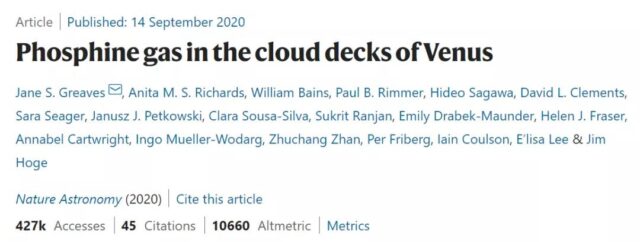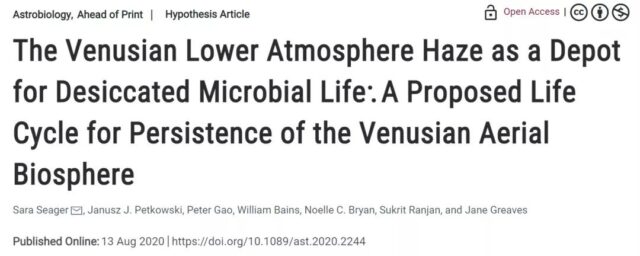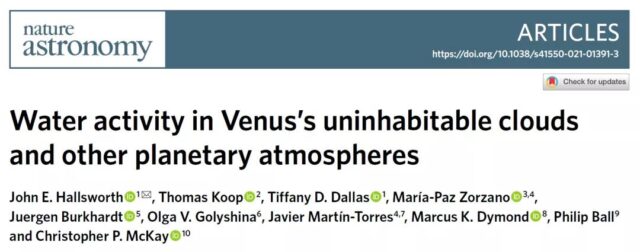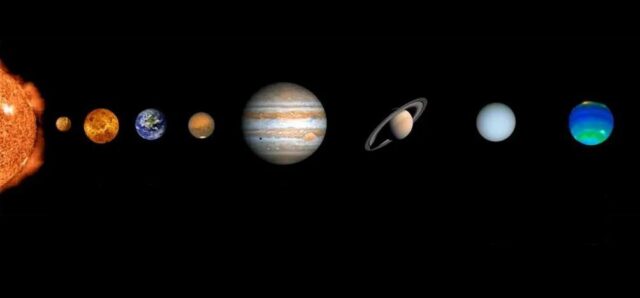Nature: Hope is extinguished since there is no life in the clouds of Venus
- Normal Liver Cells Found to Promote Cancer Metastasis to the Liver
- Nearly 80% Complete Remission: Breakthrough in ADC Anti-Tumor Treatment
- Vaccination Against Common Diseases May Prevent Dementia!
- New Alzheimer’s Disease (AD) Diagnosis and Staging Criteria
- Breakthrough in Alzheimer’s Disease: New Nasal Spray Halts Cognitive Decline by Targeting Toxic Protein
- Can the Tap Water at the Paris Olympics be Drunk Directly?
Nature: Hope is extinguished since there is no life in the clouds of Venus
Nature: Hope is extinguished since there is no life in the clouds of Venus. On September 14, 2020, Nature Astronomy published an explosive paper.
A research team composed of several top research institutions in the United Kingdom, the United States, Japan and other countries found that there is an abnormal concentration of phosphine in the atmosphere of Venus (PH3) gas, reaching 20ppb (two parts per billion). Under normal circumstances, there should not be such a high concentration of phosphine on Venus.
On the earth, anaerobic microorganisms can produce phosphine. In addition, Venus is similar to the earth. For example, the radius of Venus is 0.95 times that of the earth, the orbital radius is 0.72 times that of the earth, and the surface gravity is 0.9 times that of the earth. Therefore, many people believe that Venus may have life.
After the paper went online, the Royal Astronomical Society released a tweet saying that Venus may have signs of life, and then the director of NASA forwarded the news and commented: Is there life on Venus? It’s time to give priority to Venus.

However, a research team pointed out that, in fact, the so-called “phosphine” found in the paper is sulfur dioxide, which is very common on Mars and does not indicate a connection with signs of life. Since then, the authors of the paper discovered that the original processing of the AMLA Observatory data on which the conclusions in their paper were based was incorrect, which affected the research conclusions.
In addition, in August 2020, researchers from the Massachusetts Institute of Technology published a paper in Astrobiology, pointing out that the environment at 50 kilometers of the atmosphere of Venus is similar to that of the earth, with a temperature of about 30°C, and microorganisms may exist here.

So, can microorganisms exist in the atmosphere of Venus? Unfortunately, a recent study gave a negative answer.
On June 23, 2021, researchers from Queen’s University and other units published a research paper titled: Water activity in Venus’s uninhabitable clouds and other planetary atmospheres in Nature Astronomy.
The study pointed out that Venus, like most planets in the solar system, has relatively low water availability in the clouds, making it difficult for even life forms that have adapted to the extreme environment of the earth to survive. This finding shows that most planetary environments with cloud cover are not conducive to life as we know it.

Venus is close to the earth in size and gravity, but because it is closer to the sun, it has a higher temperature. And because 96.5% of the atmosphere of Venus is carbon dioxide, a greenhouse gas, the surface temperature of Venus exceeds 400°C. In addition, due to sulfur and oxygen compounds in the atmosphere of Venus, it often rains sulfuric acid.
The environment of Venus is too harsh, which is obviously not suitable for life, even the strongest microorganisms on the earth. Some researchers believe that life on Mars is most likely to exist in the atmosphere, and microorganisms may exist in the clouds.

Water activity is measured in the range of 0-1, which is equivalent to the relative humidity or water availability in the planetary atmosphere. The water activity in the environment has a great impact on organisms, including organisms called extremophiles that live in extreme environments. Laboratory studies have shown that life requires at least 0.585 water activity to metabolize and reproduce.
John Hallsworth and others calculated the limits to life caused by water activity in the clouds of Venus and other planets in the solar system. They found that droplets of sulfuric acid reduced the water activity in the clouds of Venus to less than 0.004, which is less than one percent of the life limit.
In contrast, the water activity in the Martian clouds is 0.537, which is only slightly lower than the habitable range for life, and close to the second layer of atmosphere, the stratosphere. However, only the lowest layer of the earth’s atmosphere (the troposphere) is suitable for life. The water activity of Jupiter’s atmosphere allows life to exist, higher than 0.585, and the temperature is between -10°C and +40°C, but the composition of clouds and other factors limit its habitability.
Finally, the author of the paper concluded that this study showed that the relative availability of water in the Martian atmosphere and clouds is too low, and even life forms that have adapted to the extreme environment of the earth cannot survive. The method used in the study further shows that most planetary environments with cloud cover are not conducive to life as we know it. This method can also be applied to determine the atmospheric water activity of planets outside the solar system, thereby narrowing the scope of the search for extraterrestrial life.
(source:internet, reference only)
Disclaimer of medicaltrend.org
Important Note: The information provided is for informational purposes only and should not be considered as medical advice.



